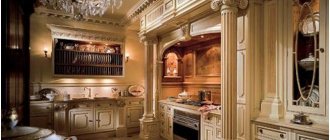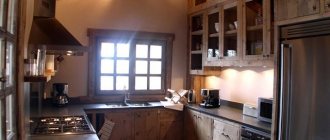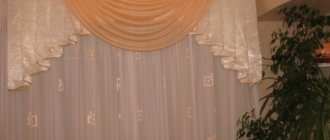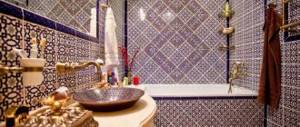Materials
The main materials, of course, are wood and stone. In view of this, solid wood furniture is best suited for the Russian style.
When it comes to choosing flooring, the ideal solution would be to use natural hardwood beams. Naturally, if necessary, you can use laminate, ceramic tiles or linoleum stylized for them.
The best option for frames would be wooden frames with carved platbands. In the absence of the opportunity to install wooden frames, you can choose a plastic double-glazed window stylized as wood. To finish the ceiling, beams or moldings or stucco are used.
Accessories
To complement the style, it is better to choose painted or carved cutting boards, a samovar, homespun round rugs, linen curtains, garlic and onion braids - such traditional items are used to create an authentic atmosphere.
Painting is actively used for finishing facades, aprons, and textiles.
Of course, it is necessary to remember that moderation is needed in everything. If you overdo it even a little with such “clichés” as horseshoes, samovars and nesting dolls, then a kitchen in Russian folk style will turn into a tastelessly decorated room.
Decorating ideas with traditional accessories
In addition to woody shades, Russian cuisine welcomes colors such as red, blue, white, yellow and green. In order not to turn the room into a rainbow, all colors must be dosed and used mainly in ornaments and accessories. How can beautiful interiors decorated according to folk motifs surprise us? These are all kinds of painted dishes, plates, samovars, mugs, clay pots, jugs, bast and wicker baskets, stands and rolling pins made of wood... The list of suitable utensils is simply endless!
Items painted using the Gzhel and Khokhloma techniques are a real exclusive in the kitchen. The Gzhel technique involves the use of white and blue to create patterns, and Khokhloma - a black, red and green palette on a golden background.
Finally, folk style cannot do without original textiles. It is very important that the tablecloth, napkins, covers for stools and benches, as well as towels are made from natural materials (for example, linen or cotton). Of course, the textiles should be decorated with traditional embroidery, subtly emphasizing the folk color, which is confirmed by the photo of the kitchen interior below.
Furniture and decoration
A good-quality table with massive stools, open shelves, benches, and chests are typical for any kitchen decorated in the Russian style. Finishing elements in the form of folk carvings and decorative paintings are required.
It is highly advisable to hide household appliances behind facades. A Russian stove can be imitated by designing a special outlet for the hood above the stove.
To decorate and decorate the doors, hand carvings, iron inserts, and painting in dark colors are used.
Features of the Russian style
If you decide to make a kitchen without a stove, you can try to style an island or other kitchen elements as it
Russian style is closely intertwined with rustic style, because the main points in them completely coincide:
- Decorative painting of design elements;
- Natural materials in room decoration;
- Characteristic furniture (antique chests, wooden sideboards, long benches, cabinets and tables decorated with painted ornaments).
- An abundance of accessories (lace curtains, embroidered napkins and towels, decorative wooden tableware, wicker and bast products);
- Russian stove.
When a “Russian kitchen” is planned, the choice of finishing materials, furniture and accessories plays a predominantly important role in its design. In a spacious kitchen, you can safely place a Russian stove, decorating it with hand-painted tiles or decorating it with your own hands. In a small kitchen you can install a decorative fireplace.
Khokhloma style
The interior of the kitchen in the Khokhloma style is distinguished by its special painting, which originated in the 17th century in Nizhny Novgorod. In those days, such painting was applied to wooden dishes, nesting dolls and other wooden crafts.
A kitchen set with facades decorated with such painting looks original and festive.
As you can see, the painting adds mood to the entire interior. If you want to leave the facades of the set without painting, then “Khokhloma” can be used to decorate, for example, a kitchen apron.
Khokhloma, Khokhloma painting - history of the craft and photos
The ancient art of Khokhloma painting is now experiencing a new flourishing.
Wooden dishes and furniture sparkling with gold and flaming with cinnabar patterns are world famous. The wonderful Russian artistic craft, which arose in the 17th century in the Volga region, near the trading village of Khokhloma, from which it received its name, has turned into one of the largest centers of folk art in our country. In the last century, Khokhloma spoons and bowls were part of everyday peasant use. Khokhloma entered the life of Soviet people in a new way: magnificent sets decorated the festive table, decorative vases and panels fit into the ensemble of the modern interior and enlivened it; small things - boxes, ladles - became favorite souvenirs, painted beads, brooches and bracelets - an elegant addition to a woman’s costume.
And yet, among the various products of the Khokhloma craft, sometimes having a purely decorative purpose, the most important place is occupied by dishes. Today, along with traditional cups, spoons, barrels, and supplies, Khokhloma artists offer beautiful and easy-to-use kitchen sets, sets for fish soup, berries, honey, and milk, consisting of several items. This bright colorful dish seems to emanate generosity and Russian hospitality.
But the growing fame of Khokhloma is explained not only by the fact that Khokhloma products are practical and pleasant to use, and can serve as decorative decorations or original souvenirs. In our time, the significance of Khokhloma painting as a distinctive area of Russian folk art, a unique phenomenon of national culture, is becoming increasingly clear. In works created by the hands of modern craftsmen, the artistic experience of many generations of talented wood turners, carvers and painters comes to life.
When you look at cups, stands, barrels, salt pans carved from light wood, you never tire of admiring the strict beauty of the forms, the sonorous decorativeness of the painting, which turned these modest household items into genuine works of art.
The motives of Khokhloma painting are simple and poetic. They are limited to floral and simple geometric patterns. Flexible grasses or twigs with golden elastic curls of leaves softly spread over the convex surfaces of objects. Flowers and bunches of berries are woven into the pattern. The compositions, sometimes strict and laconic, sometimes refined and lush, embodied the Russian people’s love for nature and their desire for beauty.
The cheerful structure of the painting acquires a festive solemnity thanks to the superbly found colorful range: sparkling gold, scarlet cinnabar and deep black tone. Strict color combinations and the bright shine of gold give wooden bowls a resemblance to precious utensils. This is all the more remarkable since Khokhloma “gold” is a product of the ingenuity of Russian artisans.
And getting the effect of gold on wood is not so easy: unpainted products are primed, covered with linseed oil, rubbed with aluminum powder (in the past - tin, less often silver). The dishes “silvered” in this way are painted with oil paints that are resistant to high temperatures, varnished and hardened in an oven. When heated, the varnish turns yellow, turning “silver” into “gold”, softening the brightness of the color of the painting with an even golden tone.
The secrets of technology and the wonderful traditions of this type of folk art are preserved and improved by two large artistic enterprises located in the Gorky region: “Khokhloma Painting” in the city of Semenov and “Khokhloma Artist” in the villages of Semino, Kuligino, Novopokrovskoye, Koverninsky district. The renowned teams unite about a thousand masters. The work of many of them has received high awards.
It is no coincidence that the Volga region became the birthplace of Khokhloma painting. The forest region in the northeast of the former Nizhny Novgorod province has long been famous for its skilled craftsmen. Numerous artistic crafts were preserved here until the end of the 19th century, among which, thanks to the abundance of forests, wood processing occupied a special place. Khokhloma was only the only branch of the art of carving, turning and wood painting widespread here.
Peasant utensils were lavishly decorated with carvings and paintings: sleighs, horse bows, spinning wheels, rollers, weaving mills, and dishes. Folk craftsmen carved intricate patterns on gingerbread and printed boards; they made chipped and turned toys for children. The carved decoration of huts was especially sophisticated in the Volga region. The pediment, walls, and gates were covered with decorative boards depicting lush floral patterns and fantastic creatures - the Syrian bird, mermaids, lions with a flowering branch instead of a tail.
To enhance the impression of elegance, house carvings, like carvings on utensils, were colored. But the desire of peasant artists for bright colors was even stronger in the painting of wooden toys, bast boxes, birch bark tues, Khokhloma dishes and Gorodets spinning wheels.
Gorodets painting, which arose in the second half of the 19th century in the vicinity of Khokhloma painting, is completely different from it. In the villages near Volzhsky Gorodets, famous for its noisy bazaars, peasants painted funny pictures on the wide bottoms of spinning wheels: elegant “couples”, dashing riders on steep-necked horses framed by lush roses or colorful bouquets, cheerful treats.
And today this peasant painting delights us with its boldly bold pictorial manner, the sonorous harmony of rich blue, yellow, black and pink-red tones. Everyday scenes pointing to the later origin of Gorodets painting, the floridness of the colorful range, and the technique of “cold” coloring in contrast emphasize the unique originality of the purely ornamental motifs of Khokhloma, its strict solemn coloring and unusual technology generated by the artistic culture of the 17th century.
In the history of folk crafts of the Volga region, Khokhloma craft has occupied a special place not only in the breadth of its distribution, the number of workers employed, the volume of manufactured products, the scope of trade, but also in its amazing viability.
The Khokhloma coloring method most likely originated in the 17th century. In any case, even then, metal powder in decorating wooden utensils was widely used by Nizhny Novgorod craftsmen, for example, in the estates of boyar Morozov, who, in a letter to his clerks in 1659, demanded to send him “one hundred dishes of red frying pans (i.e., painted. - T E.) and for the tin business
. But whether this dish was similar to gold is unknown.
It is quite possible that the development of Khokhloma technology was influenced by the icon-painting craft developed in the schismatic monasteries of the Trans-Volga region - silver powder under drying oil was used to gild the background of icons. Using this technique, close to Khokhloma, local icon painters tried to create purely ornamental compositions. The Gorky Art Museum houses 17th-century icon cases painted with lush floral patterns reminiscent of precious oriental fabrics. Fantastic golden flowers and intricately shaped leaves sparkle against red and green backgrounds.
The spread of the method of simulating gold in painting peasant utensils was apparently caused by the desire to imitate expensive utensils carved from valuable wood, painted with cinnabar and painted with real gold. It was common among the boyars, and was made in monasteries and, in particular, in the Tronets-Sergius Lavra, to which the Trans-Volga villages of Khokhloma and Skorobogatovo were assigned in the 17th century. From the documents of the monastery it is clear that peasants from these villages were called to work in the workshops of the Lavra, where they could get acquainted with the production of festive bowls and ladles. It is interesting that it was the Khokhloma and Skorobogachov lands that became the birthplace of original folk painting and dishes that look like precious ones.
The abundance of forests and the proximity of trade routes contributed to the development of fishing. In 1810, the Russian geographer Evdokim Zyablovsky reported that in the villages of the Nizhny Novgorod province, located on the left bank of the Volga, “peasants sharpen and varnish various wooden utensils. Their goods are light, clean, strong, and both their yellow and black varnish, which they make from linseed oil, is very strong and light.”
By the middle of the 19th century, the fishery had grown significantly. “The activity in the Khokhloma volost is extraordinary,” wrote the Nizhny Novgorod Provincial Gazette in 1855, “in some villages they prepare baklushi, in others they sharpen cups from baklush, and in others they paint them. . ."
Ten villages of Semenovsky district (Vikharevo, Koshelevo, Sivtsevo, Berezovka and others) painted 930 thousand pieces of tableware in 1870. They were competed with by the Skorobogatovskaya volost of the neighboring Kostroma province, where painting was practiced in Bolshie and Malye Khryaschakh, Semin, Rossadin, Mokushin, Vorotnevo and the village of Bezdeli, which received its name because its inhabitants did not sow grain like other peasants, but lived only on income from fishing.
In the second half of the 19th century, all kinds of cups, five types of caviar dishes, turned mugs, barrels, lacquer canes and snuff boxes were made here. The furniture with Khokhloma patterns, which was made in Bezdelye by the Krasilnikov family, was also famous. By this time, Khokhloma painting had accumulated certain traditions, its characteristic techniques and types of compositions had developed.
The art of Khokhloma in its origins is closely connected with ancient Russian decorative culture. In Khokhloma ornaments one can see a connection with floral patterns of icons and frescoes, manuscripts, fabrics and utensils of the 17th century. In the process of development, peasant painting experienced various influences, but, having processed them, it created its own special style, largely determined by the tasks of mass production of cheap utensils for peasant use.
The principles of its decoration are varied and depend on the shape, size and purpose of the item. The cheapest bowls that could be found in any village hut had simple ornaments. The master, having dipped a stencil made from a piece of felt, a dry puffball mushroom or a porous sponge into paint, confidently applied black and red diamonds, stars, and spirals to the surface of the bowl. They alternated on a golden background in a strict rhythmic order, sometimes combined with light strokes, sometimes scattered along the side, sometimes forming a semblance of a flower at the bottom. Already in these primitive compositions, the remarkable decorative flair of the village artist was evident, his ability to fill the surface of an object with a pattern, leaving no voids anywhere, but also without filling the golden background with paint. Using meager means, the master created elegant, pleasing to the eye painting.
Things that were larger or more complex in shape were painted with the so-called grass ornament. It was executed with quick, laconic brush strokes, similar to blades of grass or feathery leaves. The light openwork pattern covering the golden dishes, barrels, and supplies emphasized the beauty of their proportions and the plasticity of their silhouette.
In this regard, the painting of “artel” bowls is noteworthy, huge, “up to one and a half arshins in diameter,” from which an entire artel could be fed.
Sometimes there was an inscription on them: This bowl is for barge haulers, it’s nice to eat for their health.
We serve the owner and sing a song. At the bottom of such a bowl, the master, as a rule, placed a rosette of “herbs.” This composition was popularly called “saffron milk cap,” either because of its resemblance to a wild mushroom, or because it resembled the sun—red-haired Yarilo. Often the rosette fit into a rhombus, forming a kind of gingerbread.
The pattern in the center, emphasizing the bottom, was framed by a plant branch. It lay on the side of the bowl like a lush wreath and seemed to blossom before our eyes, throwing out elastically curled shoots with clusters of berries one after another. It is convenient to spread such an ornamental motif on the spherical surface of an object, and thanks to repeated repetition, its design acquires clarity and completeness.
In another case, the composition is built on the principle of contrast—the “gingerbread” is enlarged, and swirling strokes running in one direction are boldly thrown along the side, like the feathers of a fairy-tale bird. Their rapid rhythm darkens the immobility of the “carrot”. Khokhloma carefully preserves herbal patterns taken from antiquity, and sometimes unexpectedly boldly reworks them, creating endless and varied options: a wavy branch on a bowl, lush bushes on a pot-bellied barrel or a squat saltbox, graceful “sedges” on a slender stand, and on its lid - a steeply curved spiral branch.
The imagination of a peasant artist is inexhaustible: the ornament is never repeated exactly, and each new version of it is a skillful improvisation, executed without a preliminary drawing. That is why the techniques of “horse” writing used to create “grass” are so expressive: flexible strokes - blades of grass - lie in silhouette on top of the golden background. The rhythms of painting are determined by the movements of the brush, sometimes bold and energetic, sometimes smooth and leisurely, but always confident and precise.
The style of painting, developed by more than one generation of artists, combines precise techniques with spontaneity and apparent simplicity: we see how the paint froze at the touch of a brush, giving life to wonderful leaves and herbs. The rich strokes and light strokes are extremely conventional and contain only a hint of form, but immediately evoke in our imagination a lively and vibrant image of a flowering plant.
In these fiery bursts of cinnabar - the generosity and richness of the soul of the Russian man, in them - a living sense of nature and the peasant's dream of beauty, his desire to turn a modest blade of grass into a strange plant, climbing with bizarre curls. The same thing is sung in folk wedding songs: “golden hops” curl, “azure flowers” bloom on the groom’s way to the bride, “silk grass” bends.
The grass ornament was the most favorite among the peasants, but there were also compositions without “grass”, “under a leaf” - an image of leaves on branches that were simple in design, or those where the “grass” was an addition to the main pattern. For example, a “shaft” with large flowers and leaves, curly tendrils.
The “Horse” letter is one of the directional Khokhloma paintings, associated with the tradition of free brush paintings that existed in the Volga region in the 17th-18th centuries. Other techniques and decorative principles are developed by the “background” writing that emerged in the middle of the last century.
Its execution is more complex: the artist outlines the contours of the design with a thin black line, then paints over the red background, and fills in the left silver pattern, that is, enlivens it with light strokes and shades it with shading. After varnishing and oven-hardening, golden flowers and leaves will sparkle against a festive scarlet or deep black background.
This is how they wrote “kudrina” - an ornament formed by golden curls. They, following each other, like the crests of waves, create an elegant golden border. They liked to place such a strip along the edges of bowls and bowls.
Often the “curl” motif is a large branch with succulent leaves, reminiscent of plant patterns in house carvings. According to the stories of the old master N. G. Podogov, Khokhloma artists reworked these patterns in their own way, changed the composition, adapting it to the convex surfaces of turned dishes, and gave the leaves more rounded outlines.
I liked “Kudrina” for its generality, the play of flat golden spots. Bowls and spoons were decorated with such painting, but it was especially beautiful on large objects - large bowls, arches, round stools. On arches made in the middle of the last century, there are also patterns with smaller branches, intercepted by rings and curly leaves. They resemble the ornaments of ancient handwritten books preserved by the Old Believers.
Obviously, these drawings influenced the composition of the “curl” motifs, and perhaps determined the graphic nature of its techniques: instead of rich strokes of “grass”, giving the impression of picturesqueness and volume, a contour line, a flat golden spot, and a subtle touch in the elaboration of details dominate here.
However, the complex and labor-intensive “background” letter was apparently performed only on gift items or for special orders. Few such things have come down to us, and often they were signed or had inscriptions: This is the arc of the peasant Simeon Ivanov, Grishin village. Retkino 1853.
The technique of “horse” writing, thanks to the ease and laconicism of its techniques, remained the main one in decorating mass-produced tableware, which was sold in batches of a thousand pieces. Light, durable, elegant and cheap Khokhloma bowls, spoons, supplies and dishes were widely sold in Russia and exported abroad. The main trade route was the Volga.
In the spring, as soon as the river was cleared of ice, barges loaded to the brim with “wood chips” sailed to Gorodets or to Nizhny Novgorod and Makaryev, famous for their fairs, and from there to the Saratov and Astrakhan provinces. Khokhloma dishes were delivered through the Kyrgyz steppes to Persia, India, and Central Asia. From Nizhny she went to Siberia, to the White and Baltic seas. The British, Germans and French bought it in Arkhangelsk. Travelers encountered Khokhloma cups in remote cities of America, Africa and Australia.
Despite the growing popularity of Khokhloma painting, at the end of the 19th and beginning of the 20th centuries, the craft experienced a severe crisis caused by rising timber prices and increased competition from factory-made tableware. Craftsmen had to produce the cheapest types of dishes, and painting degenerated into rough, careless brushstrokes. Professional artists sent by the Nizhny Novgorod zemstvo to teach handicraftsmen new drawings introduced an element of cold stylization into the painting.
The Great October Socialist Revolution opened a new page in Khokhloma art. In the first decrees of the Soviet government, concern for the protection and development of folk art was felt. The decree of the All-Russian Central Executive Committee played an important role in his fate. signed by V.I. Lenin and M.I. Kalinin on April 25, 1919. “On measures to promote the handicraft industry.” Khokhloma artisans, like masters of other crafts, received the necessary financial support and raw materials. They united into artels and moved from cramped dyeing shops to bright and spacious public workshops. In 1918, a school of Khokhloma painting was opened in Semenov.
An exhibition of works of peasant art organized in the halls of the State Historical Museum in 1921 showed its true beauty and significance, prompting Khokhloma artists to turn to the study of the rich heritage of the past. The time of revival of the truly folk character of painting was the 1920-1930s. Its best traditions were preserved and passed on to the younger generation of artists by old masters: S. S. Yuzikov, the Krasilnikov brothers, A. M. Serov, P. F. Raspopin, the Pologov family and others.
However, the traditions of pre-revolutionary art of Khokhloma have been rethought in the spirit of the times. As a result, at the Exhibition of Folk Art, which took place in 1937 at the State Tretyakov Gallery, new original works by Khokhloma artists appeared. In these works, based on the ancient “herbal” writing, various variants of plant patterns were created. Artists began to place flowers, patterned leaves, strawberries, currants, raspberries, and ears of rye among flexible grasses, and depict birds and sometimes fish in patterns of grass-algae. For the first time, the joyful feeling of life was clearly embodied in the Khokhloma ornament, and its content became rich and emotional.
The following decades were full of intense quests: the art of Khokhloma was enriched with new discoveries. The highest creative achievements are associated with the current stage in the life of the craft. The work of Khokhloma masters in collaboration with employees of the Moscow Research Institute of the Art Industry - V. M. Vishnevskaya - brings excellent results. 3. A. Arkhipova, A. V. Babaeva. E. I. Vorontsova.
In the experimental laboratories that opened in Khokhloma factories, artists create a rich assortment of products that are becoming increasingly popular today. There are a variety of dishes, decorative vases, ladles, panels, sets of dismountable children's furniture, light and comfortable coffee tables. Among the new souvenir products are elegant vases, powder compacts, a set of three miniature stands, nested one inside the other and painted with “grass”, “curl” and “under the background”.
In developing the plastic qualities of new products, the authors strive to make fuller use of the specifics of wood. Taking as a basis the types of traditional Russian wooden utensils—bowls, bratins, postavtsy, tubs, large mugs for kvass—the artists interpret the form in their own way, giving it a sharper expressiveness, emphasizing slenderness and lightness or, on the contrary, massiveness and squatness. This is achieved by changing the proportions, silhouette, and original design of details - handles, lids.
Thanks to the new decorative purpose of Khokhloma products, the aesthetic basis of Khokhloma was further developed. Khokhloma painting today has become unusually subtle, virtuosic, and emotional. Having perfect mastery of all types of writing, artists create endlessly varied designs. And in any composition one can feel the bright individuality of the master. Even in seemingly monotonous, at first glance, grass patterns, we can easily distinguish the large, juicy “grasses” of A. I. Kurkina from the delicate “grass” of N. A. Denisova or light dynamic, as if bent by a gust of wind, scarlet “grasses” "E. N. Dospalova.
The colorful range of painting has become more complex and richer. Within the traditional color scheme, craftsmen are looking for new interesting combinations, arranging the primary colors into similar shades: yellow-orange highlights appear on red berries, and tints of greenish-brownish tones appear on the leaves, softly combined with gold. The Khokhloma palette seems to absorb the colorful richness of the autumn forests, among which the painting was born.
Artists highlight the richness of Khokhloma patterns with gold stripes, chiseled decorative rings, and grooves, which give the product a special elegance. In modern Khokhloma art, two directions have been identified.
In the Koverninsky region, where craftsmen work in villages lost among dense forests, the figurative structure of the painting is largely determined by direct life impressions.
The predominant motifs here are “grass,” modest wildflowers, leaves and catkins of birch, linden, and wild berries. The rhythms of the drawing are smooth and unhurried, but the brush strokes are picturesque and bold. “We love living berries, freedom in painting
,” say the Kovern artists.
Each of them has its own special manner of performance. The work of L. I. Maslova is distinguished by its subtle lyricism. She embodies the gentle, friendly image of nature in compositions with a gooseberry motif. On flexible branches it depicts patterned soft green leaves and striped golden-yellow berries. Through their shaggy skin, golden streaks seem to shine through in the sun.
K.V. Mosnaya’s paintings with raspberries, rowan berries and currants are akin to a cheerful peasant song. They exude a freshness of feeling, a purely folk understanding of color - sonorous, bright, full-blooded. Thin lines coexist here with a bold stroke and a “poke” (“frog”), which is applied with the end of the brush. With such “pokes” the craftswoman paints blackberries and raspberries, the crown of a tree, and clover flowers.
O. P. Lushnna stands out among other craftswomen with her picturesque temperament. She often builds compositions on the play of large spots of color, abandoning the traditional flexible stem or bush. The artist boldly scatters fiery red leaves across the golden background of bowls and vases. These bright, juicy spots, like ringing musical chords, give the figurative structure of the painting a special elation and majorness.
Modern “background” writing has become unusually effective. Floral patterns that are executed in this technique, thanks to special techniques, received a new original interpretation: either in the densely ornamented paintings of A.T. The beaded flame of berries and the gold of leaves contrast with the velvety-black depth of the background, or they shine on it like stars at night the sky, golden rosette flowers in the works of O. L. Veselova. Master P. A. Novozhilova loves a red background, which gives the image a special festivity. The designs of the Kovernin “curls” are soft and flexible. True, they are performed here less often than in the city of Semenov.
The city of Semenov is another major center of Khokhloma, where this art develops somewhat differently. Although both Semyonov and Kovernin artists are subtle connoisseurs of all types of writing, both have their own favorite motifs and techniques. The differences in the nature of their painting have been evident for a long time. In 1937, at the “Folk Art” exhibition at the Tretyakov Gallery, two decorative panels aroused particular interest. One of them belonged to the Kovernin master A.G. Podogov.
Using the ancient motif of the “shaft” composition, he depicted screaming starlings among fresh greenery and fluffy bird cherry flowers. He managed to create a poetic and at the same time vital image of spring Russian nature. The work of Semyonovsk artist A.P. Kuznetsova fascinated with its fabulousness: on a lush branch with magic apples, an elegant bird-Pava with fiery golden-orange plumage.
Semyonovtsev and later were attracted by complex and lush compositions with fantastic birds, flowers and bizarrely shaped leaves, which they performed in a light graphic manner.
Lately, Semyonov craftsmen have been working a lot and willingly on the “Kudrina” ornaments, painting them finely, with a jeweler’s finesse.
M. F. Sineva’s “curl” motifs are unique and unusual. They vary in the image of an exotic flower formed by golden curls and reminiscent of an oriental fan.
If Kovernn craftswomen each try to preserve their individual “handwriting,” then in the city of Semenov talented artists A. P. Savinova, N. P. Salnikova, N. V. Morozova, N. I. Ivanova, M. M. Gladkova, creating new compositions often work together. Each can always continue or finish the other's work. The table sets made by a team of craftsmen under the leadership of I.K. Sorokin are especially good.
Various objects are painted with patterns of rare beauty. You can endlessly admire the filigree ornament of small golden leaf curls on a flexible stem. Curving whimsically, golden branches lie on the red background of cups, cups and ladles like elegant openwork lace. The magnificent ceremonial painting corresponds to the purpose of the festive tableware. The works of Semenov and Kovernin artists perfectly complement each other, giving an idea of the rich and varied possibilities of modern Khokhloma painting.
T. I. Emelyanova. 1974











